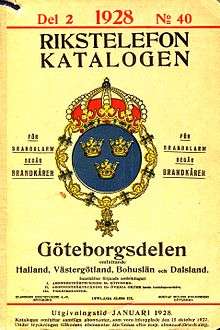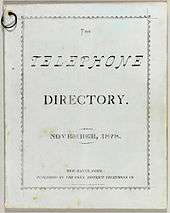Telephone directory

A telephone directory, also known as a telephone book, telephone address book, phone book, or the white/yellow pages, is a listing of telephone subscribers in a geographical area or subscribers to services provided by the organization that publishes the directory. Its purpose is to allow the telephone number of a subscriber identified by name and address to be found.
The advent of the Internet and smartphones in the 21st century greatly reduced the need for a paper phone book. Some communities, such as Seattle and San Francisco, sought to ban their unsolicited distribution as wasteful, unwanted and harmful to the environment.[1][2]
Content
Subscriber names are generally listed in alphabetical order, together with their postal or street address and telephone number. In principle every subscriber in the geographical coverage area is listed, but subscribers may request the exclusion of their number from the directory, often for a fee; their number is then said to be "unlisted" (American English), "ex-directory" (British English), "private" or private number (Australia and New Zealand), or "non-published" (Canada).[3]
A telephone directory may also provide instructions: how to use the telephone service, how to dial a particular number, be it local or international, what numbers to access important and emergency services, utilities, hospitals, doctors, and organizations who can provide support in times of crisis. It may also have civil defense or emergency management information. There may be transit maps, postal code/zip code guides, international dialing codes or stadium seating charts, as well as advertising.
In the US, under current rules and practices, mobile phone and voice over IP listings are not included in telephone directories. Efforts to create cellular directories have met stiff opposition from several fronts, including those who seek to avoid telemarketers.
Types
A telephone directory and its content may be known by the color of the paper it is printed on.
- White pages generally indicates personal or alphabetic listings.
- Yellow pages, golden pages, A2Z, or classified directory is usually a "business directory", where businesses are listed alphabetically within each of many classifications (e.g., "lawyers"), almost always with paid advertising.
- Grey pages, sometimes called a "reverse telephone directory", allowing subscriber details to be found for a given number. Not available in all jurisdictions. (These listings are often published separately, in a city directory, Polk directory, or under another name, for a price, and made available to commercial and government agencies.)
Other colors may have other meanings; for example, information on government agencies is often printed on blue pages or green pages.
Publication

Telephone directories can be published in hard copy or in electronic form. In the latter case, the directory can be used provided as an online service through proprietary terminals or over the Internet, or on physical media such as CD-ROM. In many countries directories are both published in book form and also available over the Internet. Printed directories were usually supplied free of charge.
History
Telephone directories are a type of city directory. Books listing the inhabitants of an entire city were widely published starting in the 18th century, before the invention of the telephone.
The first telephone directory, consisting of a single piece of cardboard, was issued on 21 February 1878; it listed 50 individuals, businesses, and other offices in New Haven, Connecticut that had telephones.[4]
The first British telephone directory was published on 15 January 1880 by The Telephone Company. It contained 248 names and addresses of individuals and businesses in London; telephone numbers were not used at the time as subscribers were asked for by name at the exchange.[5] The directory is preserved as part of the British phone book collection by BT Archives.
In 1938, AT&T commissioned the creation of a new type font, known as BELL GOTHIC, the purpose of which was to be readable at very small font sizes when printed on newsprint where small imperfections were common.
In 1981 France was the first country to have an electronic directory[6] on a system called Minitel. The directory is called "11" after its telephone access number.
In 1991 the U.S. Supreme Court ruled (in Feist v. Rural) that telephone companies do not have a copyright on telephone listings, because copyright protects creativity and not the mere labor of collecting existing information.
1996 was the year the first telephone directories went online in the USA. Yellowpages.com and Whitepages.com both see their start in April.[7]
In 1999, the first online telephone directories and people-finding sites such as LookupUK.com go online in the UK. In 2003, more advanced UK searching including Electoral Roll become available on LocateFirst.com.
In the 21st century, printed telephone directories are increasingly criticized as waste. In 2012, after some North American cities passed laws banning the distribution of telephone books, an industry group sued and obtained a court ruling permitting the distribution to continue.[1] Manufacture and distribution of telephone directories produces over 1,400,000 metric tons of greenhouse gases and consumes over 600,000 tons of paper annually.[8]
Reverse directories
A reverse telephone directory is sorted by number, which can be looked up to give the name and address of the subscriber.
In popular culture
Ripping phone books in half has often been considered a feat of strength. There are Guinness World Records for ripping the most phone books within a specific time period: the record for most phone books ripped within three minutes was established by Tina Shelton in 2007 for females (21 books)[9] and by Edward Charon in 2006 for males (56 books).[10]
The 1984 James Cameron film The Terminator features a 'cyborg assassin' protagonist sent back in time to murder the character Sarah Conner. Knowing only the name and location of the target, the cyborg uses telephone directories from public phone booths to systematically murder everyone in the local area with that name, in the order in which they appeared in the directory, causing the press and police to use the nickname 'The Phone Book Killer'.
See also
References
- 1 2 3 Yellow Pages ruling endangers SF ban, Heather Knight, San Francisco Chronicle, 15 October 2012; accessed 19 March 2013
- ↑ Appeals court rules against Seattle's curbs on yellow pages, Emily Heffter, Seattle Times, 15 October 2012; accessed 19 March 2013
- ↑ "How to get a non-published Bell Home phone number". Support.bell.ca. 2013-06-17. Retrieved 2014-04-16.
- ↑ Jason Zasky. "The Phone Book". Failure Magazine. Retrieved 2013-12-31.
- ↑ Records of the Telephone Company Limited (Bell's Patents), BT Archives reference TPA
- ↑ "Telephone History in France by". Whitepages.fr. Retrieved 2014-04-16.
- ↑ Telephone Directory History by Whitepages.fr
- ↑ Paster, Pablo (2010-01-11). "Ask Pablo: What Is The Impact Of All Those Unwanted Phone Books?". TreeHugger. Retrieved 2014-04-16.
- ↑ Guinness World Records 2016. Guinness World Records. 10 Sep 2015. p. 81. ISBN 9781910561034.
- ↑ "Most telephone directories torn in three minutes (male)". Guinness World Records. Retrieved 24 April 2017.
Further reading
- Shea, Ammon (2010). The Phone Book: The Curious History of the Book That Everyone Uses But No One Reads. Perigee Trade. ISBN 978-0-399-53593-2.
External links


- Telephone directory at Curlie (based on DMOZ)